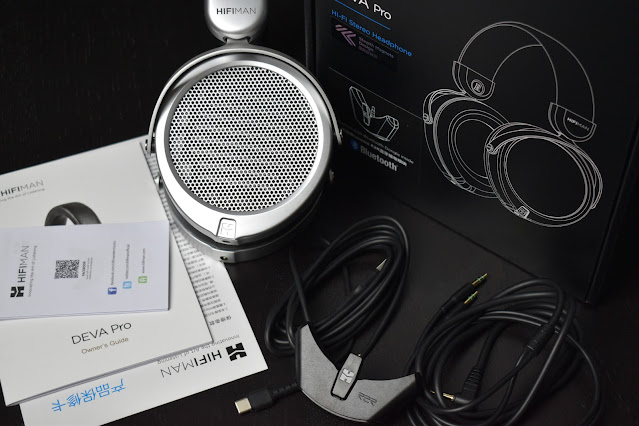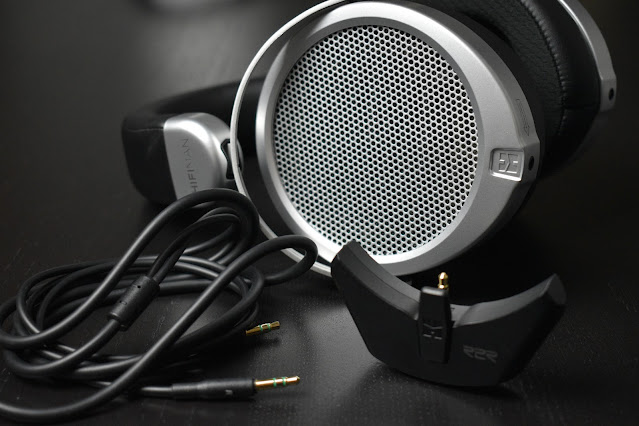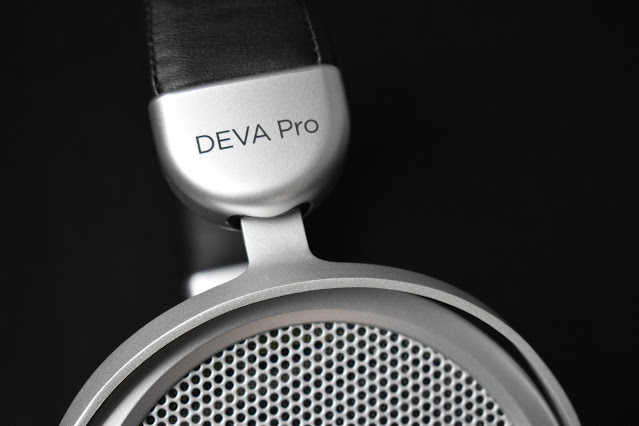- Get link
- X
- Other Apps
English | Español
Also available on YouTube in Spanish: Acho Reviews YouTube
The Deva Pro have been kindly loaned to me by Hifiman for me to evaluate them and create this review. As always, they have not requested anything at all and I will include a link to the Deva Pro on the official Hifiman site because I feel that it is the least I can do.
My review will follow the normal course of being as sincere and unbiased as possible but it is always good to take into consideration that I have not spent any of my own money to test these headphones.
Official Deva Pro page: https://hifiman.com/products/detail/313
(non-affiliate link)
Intro…
The Deva Pro are the latest Bluetooth headphones from Hifiman, although, as with the original Deva, these can also be used via cable. I’ll get into details about that as we move along, but first a little background.
Back in 2020 I reviewed the original Hifiman Deva, a set of headphones that was available with or without the Bluetooth module. In my case, I reviewed them without the module and did not get to try them via Bluetooth. I found them to be a decent set of headphones for their price at the time and although they are not my favourite Hifiman headphones, I thought they would be a good option at a reasonable price, especially for those who liked the aesthetics (check out the original Deva review here to see more).
At the beginning of 2021, I had the chance to review the Ananda Bluetooth, a more expensive set of Bluetooth headphones from the brand. The Ananda BT were far from perfect but they still remain the best sounding set of Bluetooth headphones I have heard to date. They were priced at over 1000€ at the time and, although the price has dropped since then, they still remain a quite an expensive set of Bluetooth headphones with a few quirks that didn’t convince everyone.
The Deva Pro is a new release, or a fairly recent release at least, that addresses some of the complaints from the original Deva and solves some of the issues that were commonly mentioned with the Ananda BT, for a much lower price of around 300€, which is actually a very similar price to the original Deva BT 2 years ago.
Being a fan of Hifiman, I am always interested in trying out their stuff and while I am not a huge BT headphone fan (although my use of BT has increased quite a bit since having the Go Blu), these headphones are not the typical BT headphones, but I’ll get to that.
Presentation…
As with the vast majority of Hifiman headphones, the Deva Pro arrives in the typical black box with a silk lined interior. Inside the box we find the headphones, the Bluetooth module, a couple of cables and the usual warranty cards.
I am not going to go into the packaging and presentation in much depth as I have already covered it multiple times in previous Hifiman reviews, so I will just say that there are no complaints from me as far as packaging.
I would have liked them to include some kind of storage/transport case, as Bluetooth headphones are usually something that are aimed to be portable (or at least transportable), but that is more of a wish than a complaint.
Build and aesthetics…
The aesthetics of the Deva Pro have changed quite a bit in comparison to the original Deva. The shape and style is still the same, however, the light brown tan leather pads and headband have been replaced with a more classical black look. I know there were lots of people who weren’t overly fond of the original colour scheme so I think that the more classical black and silver look will please them. Personally I liked the original Deva aesthetics but I also have no issue with the new look.
The build quality is much the same as any other Hifiman headphone of the same style. Using the headband that Hifiman chooses on the majority of their new models, there is plenty of adjustment in the cups, which should result comfortable for most people. I personally find that this style of headband does create a bit of a hotspot on the top of my head with extended use but for some reason, it doesn’t seem to be as uncomfortable (for me) over long periods as the Edition XS that I reviewed recently, possibly due to the cup shape and how the clamp to my face. Comfort wise I find it almost identical to the HE400se, which can still be improved with nuggets or the addition of a comfort strap, but is not a necessity.
Where the Deva does result far more comfortable (for me) than the HE400se is in the pad section. Where the pads on the HE400se have a kind of towelling material on the inside, the deva have a smoother material, similar to that found on the Ananda etc. Personally I much prefer this as I find the other material causes me to itch (and produces more heat).
The connections used by Hifiman on the Deva Pro consist of a dual connection, one 3.5mm connector on each cup, however, the left cup also accepts a 3.5mm TRRS connector, which is how the Bluetooth module is connected. This is a system that allows the Deva Pro to be used with both the BT module and the normal cable that is included. It also opens the possibility of using other aftermarket cables of your choice. This is something that was a complaint from many with the Ananda BT, the fact that it could only be used via BT or USB, the Deva Pro solves this issue in a way that I find well thought out and implemented.
The Bluetooth module, which I will speak about more in the functionality section next, is made of plastic and is of a simple black colour. The shape is something that is hard to describe in words, so please look at the image, but it attaches to the bottom of the left cup and has the USB-C port, a single button and the microphone on the bottom.
In general I have no complaints with the Deva Pro build or aesthetics. It is not the most beautiful Hifiman headphone (that is reserved for the Susvara and HE1000se in my opinion) but I don’t see anything that I can really complain about in the price range.
Functionality…
The way the Deva Pro works is very simple. To use it in BT mode, you attach the BT module to the bottom of the left cup, hold the button to turn it on, connect to source and away you go. To use them with a normal cable set up, just remove the module and connect the cable to both cups. I believe you can also use a 3.5 TRRS cable to just one side if you prefer, although I am not sure about the pin out, that would need to be confirmed.
As I mentioned above, the bottom of the module houses the microphone, a status LED, the USB-C port and a single button.
To connect to the source for the first time, you switch on the module (hold the button for a couple of seconds) and once it is on, press the button twice to enter pairing mode. Once it has been paired with your device, the reconnection is instant when switching the module on. One thing I did notice is that the voice that informs you that you are powered on and/or connected is at the same volume independent of your source volume or previous listening levels. The voice is a little loud for my personal tastes but this is a bit of nit picking, it’s not like she actually screams at you.
Once on and connected, the button controls play/pause by a single press, to answer/end a call it is also one press of the button, with two presses to reject a call. Unfortunately this is all the control you get from the module. There is no way to skip tracks or control volume. This is not the end of the world but personally I like to be able to control volume on BT devices as the whole point of wireless is freedom from the source, so removing your phone (for example) from your pocket to change volume or track sort of defeats the object in my opinion.
The BT module features the Hymalaya R2R DAC inside, which is supposed to offer high sampling rates with low energy consumption. The module does support LDAC, along with aptxHD and aptX, so I have no complaints as far as connectivity. LDAC is smooth and doesn’t seem to have any issues staying connected, allowing me to freely roam my office while my phone is on my desk. There are also no issues with the source being in a pocket, so no complaints from me either.
Sound…
I have been using these headphones both with the module and with the normal cable, driving them in the latter from an Asgard 3 and also from the Gryphon in the office, with no issues as far as driving them at all. While the sensitivity of the Deva Pro is rather low at 93.5dB (18 Ohms), I didn’t find that they needed any special form of amplification, although they do need more than a phone to drive them. The module drives them fine also, not seeming to lack anything in comparison to using them via cable, and they reach levels that are way above my usual listening levels. In fact, the volume level becomes painful (for me) before I even hit 75% on my source volume.
Although I have used them in both scenarios, my review is going to focus on using them mainly with the BT module, as I feel that is what makes these headphones special. I am not saying that they aren’t good without the module (I will explain more as I go on) but I think the reason for purchasing them is to make the most of the BT module with having the cabled option available.
My first impressions of the Deva Pro were that they reminded me a lot of the HE400se (a headphone that I am very fond of and is my highest recommendation at its price point). After some more detailed listening, the sound is not identical to the HE400se but it is very similar, at least in my opinion, with some slight changes that could actually be dependent on the pad difference between the two units. I haven’t yet tried swapping pads between them (I believe they fit but I'm not sure) but it would be an interesting experiment.
Starting off with the subbass, the roll off is more pronounced than on other sets of Hifiman planars. It starts to roll off around the same point as the HE400se or even the Ananda, but the actual drop is more pronounced on the Deva Pro. This means that you will not get the low rumbling bass of other alternatives but that is not something that is really expected of an open back planar anyway. The extension could be better down low and a listen to “Chameleon” quickly proves this point, however, the sub bass that is there is quick and clean, as is to be expected of a headphones of this style.
Moving into the mid bass, this is well balanced and is basically a straight line all the way into the lower mids. This is the area of these headphones that reminds me the most of the HE400se and is nothing short of great. Bass is clean and articulate, never losing control no matter how busy the track gets.
From “Black Muse” by Prince, through to “Elephants on Ice Skates” or even “Whole Lotta Love” is a pleasure to listen to. Yes, this is typical planar bass, excelling at cleanliness and speed, and I do miss some dynamic driver warmth to be totally honest, but within planar presentation of bass, the Deva Pro really does hold its own and I do not feel that it is overshadowed in the Hifiman lineup until we start reaching models that stretch into the 4 figure sums.
As we get into the mids, the transition from the bass area is excellent, with not a hint of anything becoming stressed or muddy. As we reach into the higher part of the mids, the Deva Pro are just a touch more forwards than other Hifiman options, with a bit of a boots around the 1kHz region. The typical Hifiman dip around 2kHz is still there and this little extra around 1kHz does make it a little more obvious. This doesn’t sound bad, far from it, but it is certainly not as balanced as other models. I feel that the HE400se is actually a little better in this area.
The 3kHz peak on the Deva Pro is also not really present in comparison to something like the HE400se. The highest point is actually around 5kHz and as I have mentioned in the past, my ears seem to be far more sensitive to the 5k mark than the 3k mark. This means that vocals are not quite as forward as on other models and added to the slight reduction in the low mids, and that peak at 5kHz, can mean that they lose a little of their richness, along with a bit of an extra sizzle that can be a little piercing depending on the track in question.
The extension of the treble is good, with enough air for my personal taste, although I do again feel that the HE400se is slightly better in this regard. I am not complaining about the extension or sense of air, it is far better than many competitors, but in comparison to other Hifiman products, it does fall slightly behind.
As far as soundstage and imaging, it is as good as the majority of Hifiman planars. Ok, it is quite a bit behind something like the Arya (especially if we are talking V2) but it is easily on par with something like the HE400se.
Background details are easily identified, with placement and layering being what I have come to expect as a minimum from the brand. If coming from other Hifiman models, the Deva Pro may not seem anything special in this regard, but if coming from other brands in a similar price bracket, it will certainly be something special.
Conclusion…
I have compared the Deva Pro quite a bit to the HE400se in this review, at least in regards to sound. To be totally honest, I still feel that the HE400se is the best option under 500€ for a set of planar headphones, or any headphones in general, I am just a planar lover. In a straight “sound to sound” comparison, I feel that the HE400se are a little ahead of the Deva Pro and they come in at less than half the price.
However, we are not just comparing sound, there are so many other things that fit into the equation. Where the HE400se are a simple set of headphones, the Deva Pro comes bundled with the Bluemini R2R. This opens up a whole new world of possibilities, giving them not only the possibility of being used as a bluetooth headphone (along with a mic for calls), they can also be used via USB, all while featuring a Himalaya R2R architecture DAC.
They improve on the functionality of the Ananda Bluetooth, which may sound a little better in terms of audio, but is far behind the Deva Pro in terms of usability, and here we are talking about a set of headphones that is three times the price of the Deva Pro. In this regard I would no doubt recommend the Deva Pro out of the two. I feel that the Ananda BT is a very niche product that will fit a very select number of users and use cases, however, the Deva Pro is a very versatile set of headphones that should meet anyone's use case. Obviously these are not a set of bluetooth headphones that you would use on a plane or other transport, but the commodity of being wireless whenever needed, without a loss of quality, is something to be praised.
So, as a complete package, I feel that the Deva Pro is a set of headphones that really doesn’t have any direct competition. If you feel that the usability of the Deva Pro coincides with what you are looking for, then there really isn’t anywhere else to turn.
To comment or contact, visit any of the following social media platforms:







